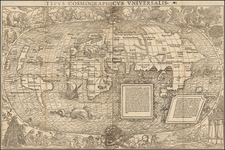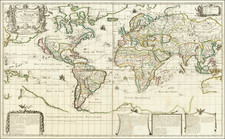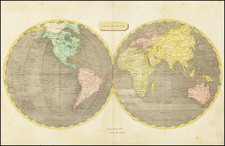Tehuantepec Railway Company's Promotional Map of the World
Fine example of this rare world map, compiled by Colonel Julius W. Adams, Civil Engineer, for the Tehuantepec Railway Company.
The map illustrates a proposal for a crossing from the Atlantic to the Pacific via the Isthmus of Tehuanepec in southern Mexico, a concept that competed in the mid 19th Century with possible routes across Panama and Nicaragua.
The map appeared in a pamphlet published by Henry Stevens entitled: Historical and Geographical Notes on the Earliest Discoveries in America, 1453-1530: With Comments on the Earliest Charts and Maps, the Mistakes of Early Navigators & the Blunders of the Geographers, the Asiatic Origin of the Atlantic Coastline of North America, how it crept in and how it crept out of the maps, the whole illustrated by the Tehuantepec Railway Company's map of the world on Mercator's projection and photo-lithographic fac-similes of many of the earliest maps and charts of America.
The introduction to the pamphlet reads:
The Tehuantepec Railway Company invites attention to a Grant or Concession for seventy years, including large grants of land, made by the Government of Mexico, on the 6th of October, 1867, to a Company to be formed by Don Emilio La-Sere, to open interoceanic communication across the Isthmus of Tehuantepec, by railroad, carriage-road, and telegraph line. It is free from all taxation or imposts of any kind by the Government, except the payment of eight per cent of the net profits of the enterprise, whenever dividends shall be declared for the stockholders, and twelve cents for each through passenger. This grant was modified and continued by the Congress of that Republic on the 29th of December, 1868; approved by the President, January 2d, 1869; and published in the Official Gazette of that Government on the 4th of January, 1809.
A fascinating piece of ephemera from the period prior to the opening of the Panama Canal.










![Nova Totius Terrarum Orbis Geographica Ac Hydrographica Tabula. A Pet. Kaerio [First State -- With Handwritten Account of Sir Francis Drake's Voyage on the verso]](https://storage.googleapis.com/raremaps/img/small/81200.jpg)
![Tabula Terre Nove [The Admiral's Map]](https://storage.googleapis.com/raremaps/img/small/81714.jpg)
![[Early Fascimile of the Disputed Christopher Columbus Portolan Chart]](https://storage.googleapis.com/raremaps/img/small/66588.jpg)

